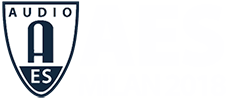AES Milan 2018
Paper Session P03
P03 - Audio Quality Part 2
Wednesday, May 23, 14:00 — 15:30 (Scala 2)
Chair:
Todd Welti, Harman International Inc. - Northridge, CA, USA
P03-1 Stereo Image Localization Maps for Loudspeaker Reproduction in Rooms—Gavriil Kamaris, University of Patras - Rion Campus, Greece; John Mourjopoulos, University of Patras - Patras, Greece
A novel approach is proposed for maps illustrating the accuracy of image source position reproduced by stereo systems in various scenarios of listening rooms / loudspeakers. Based on previous work by the authors, the maps unify results derived from an image localization classifier and the sweet spot area metric estimating the direction of arrival angles (DOA) of all potential image source positions reproduced by the system via a perceptual model. The statistical analysis of these maps indicates the skewness and kurtosis of the DOA classification error and hence the consistency and robustness of the image definition along the plane of listener positions. Results utilize such parameter mappings to objectively illustrate the robustness of this qualitative aspect of audio reproduction in rooms.
Convention Paper 9922 (Purchase now)
P03-2 Method for Quantitative Evaluation of Auditory Perception of Nonlinear Distortion—Mikhail Pahomov, SPb Audio R&D Lab - St. Petersburg, Russia; Victor Rozhnov, SPb Audio R&D Lab - St. Petersburg, Russia
All loudspeakers, amplifiers, and transmission paths introduce various types of distortion into audio signals. While energy contribution of nonlinear distortion to the distortion signal is comparatively small it has a significant impact on the sound signal quality in terms of the auditory perception. Similar energy characteristics of a nonlinear distortion signal can affect the subjective quality evaluation to different extents. This makes it important to accurately extract the nonlinear distortion signal from a musical signal in the simultaneous presence of significant distortions of other types for the auditory perception relevant objective evaluation of nonlinear distortion. The paper offers a method for quantitative evaluation of a nonlinear distortion signal in terms of its audibility and a method for prediction of subjective ratings of signals with nonlinear distortion.
Convention Paper 9923 (Purchase now)
P03-3 On the Effect of Inter-Channel Level Difference Distortions on the Perceived Subjective Quality of Stereo Signals—Armin Taghipour, Empa, Laboratory for Acoustics/Noise Control - Dübendorf, Switzerland; Fraunhofer IIS - Erlangen, Germany; Nadja Schinkel-Bielefeld, Fraunhofer Institute for Integrated Circuits IIS - Erlangen, Germany; Silvantos GmbH - Erlangen, Germany; Ankit Kumar, International Audio Laboratories Erlanged, a joint institution of Universität Erlangen-Nürnberg and Fraunhofer IIS - Erlangen, Germany; Fraunhofer IIS - Erlangen, Germany; Pablo Delgado, International Audio Laboratories Erlangen, a joint institution of Universität Erlangen-Nürnberg and Fraunhofer IIS - Erlangen, Germany; Fraunhofer Institute for Integrated Circuits IIS - Erlangen, Germany; Jürgen Herre, International Audio Laboratories Erlangen - Erlangen, Germany; Fraunhofer IIS - Erlangen, Germany
Perceptual audio coding at low bitrates and stereo enhancement algorithms can affect perceived quality of stereo audio signals. Besides changes in timbre, also the spatial sound image can be altered, resulting in quality degradations compared to an original reference. While effects of timbre degradation on quality are well-understood, effects of spatial distortions are not sufficiently known. This paper presents a study designed to quantify the effect of Inter-Channel Level Difference (ICLD) errors on perceived audio quality. Results show systematic effects of ICLD errors on quality: bigger ICLD errors led to greater quality degradation. Spectral portions containing relatively higher energy were affected more strongly.
Convention Paper 9924 (Purchase now)
